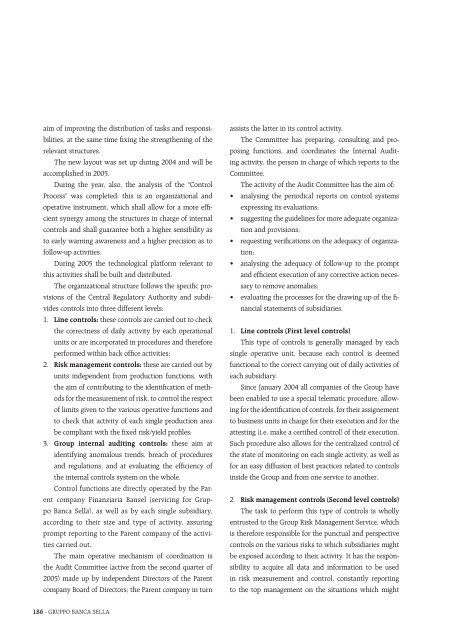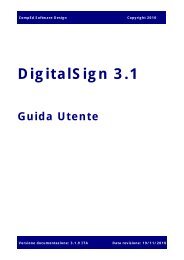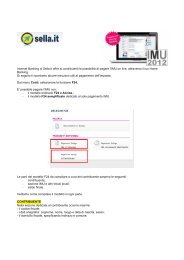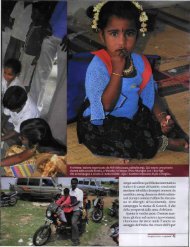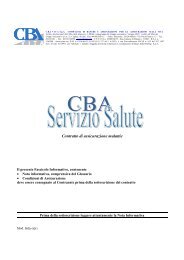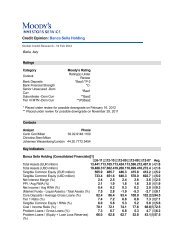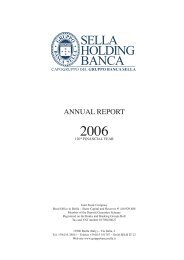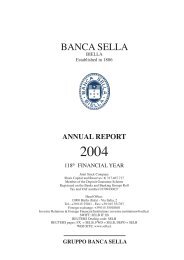consolidated annual report - Gruppo Banca Sella
consolidated annual report - Gruppo Banca Sella
consolidated annual report - Gruppo Banca Sella
Create successful ePaper yourself
Turn your PDF publications into a flip-book with our unique Google optimized e-Paper software.
aim of improving the distribution of tasks and responsi-<br />
bilities, at the same time fixing the strengthening of the<br />
relevant structures.<br />
The new layout was set up during 2004 and will be<br />
accomplished in 2005.<br />
During the year, also, the analysis of the “Control<br />
Process” was completed: this is an organizational and<br />
operative instrument, which shall allow for a more efficient<br />
synergy among the structures in charge of internal<br />
controls and shall guarantee both a higher sensibility as<br />
to early warning awareness and a higher precision as to<br />
follow-up activities.<br />
During 2005 the technological platform relevant to<br />
this activities shall be built and distributed.<br />
The organizational structure follows the specific provisions<br />
of the Central Regulatory Authority and subdivides<br />
controls into three different levels:<br />
1. Line controls: these controls are carried out to check<br />
the correctness of daily activity by each operational<br />
units or are incorporated in procedures and therefore<br />
performed within back office activities;<br />
2. Risk management controls: these are carried out by<br />
units independent from production functions, with<br />
the aim of contributing to the identification of methods<br />
for the measurement of risk, to control the respect<br />
of limits given to the various operative functions and<br />
to check that activity of each single production area<br />
be compliant with the fixed risk/yield profiles;<br />
3. Group internal auditing controls: these aim at<br />
identifying anomalous trends, breach of procedures<br />
and regulations, and at evaluating the efficiency of<br />
the internal controls system on the whole.<br />
Control functions are directly operated by the Parent<br />
company Finanziaria Bansel (servicing for <strong>Gruppo</strong><br />
<strong>Banca</strong> <strong>Sella</strong>), as well as by each single subsidiary,<br />
according to their size and type of activity, assuring<br />
prompt <strong>report</strong>ing to the Parent company of the activities<br />
carried out.<br />
The main operative mechanism of coordination is<br />
the Audit Committee (active from the second quarter of<br />
2005) made up by independent Directors of the Parent<br />
company Board of Directors; the Parent company in turn<br />
186 - GRUPPO BANCA SELLA<br />
assists the latter in its control activity.<br />
The Committee has preparing, consulting and proposing<br />
functions, and coordinates the Internal Auditing<br />
activity, the person in charge of which <strong>report</strong>s to the<br />
Committee.<br />
The activity of the Audit Committee has the aim of:<br />
• analysing the periodical <strong>report</strong>s on control systems<br />
expressing its evaluations;<br />
• suggesting the guidelines for more adequate organization<br />
and provisions;<br />
• requesting verifications on the adequacy of organization;<br />
• analysing the adequacy of follow-up to the prompt<br />
and efficient execution of any corrective action necessary<br />
to remove anomalies;<br />
• evaluating the processes for the drawing up of the financial<br />
statements of subsidiaries.<br />
1. Line controls (First level controls)<br />
This type of controls is generally managed by each<br />
single operative unit, because each control is deemed<br />
functional to the correct carrying out of daily activities of<br />
each subsidiary.<br />
Since January 2004 all companies of the Group have<br />
been enabled to use a special telematic procedure, allowing<br />
for the identification of controls, for their assignement<br />
to business units in charge for their execution and for the<br />
attesting (i.e. make a certified control) of their execution.<br />
Such procedure also allows for the centralized control of<br />
the state of monitoring on each single activity, as well as<br />
for an easy diffusion of best practices related to controls<br />
inside the Group and from one service to another.<br />
2. Risk management controls (Second level controls)<br />
The task to perform this type of controls is wholly<br />
entrusted to the Group Risk Management Service, which<br />
is therefore responsible for the punctual and perspective<br />
controls on the various risks to which subsidiaries might<br />
be exposed according to their activity. It has the responsibility<br />
to acquire all data and information to be used<br />
in risk measurement and control, constantly <strong>report</strong>ing<br />
to the top management on the situations which might


